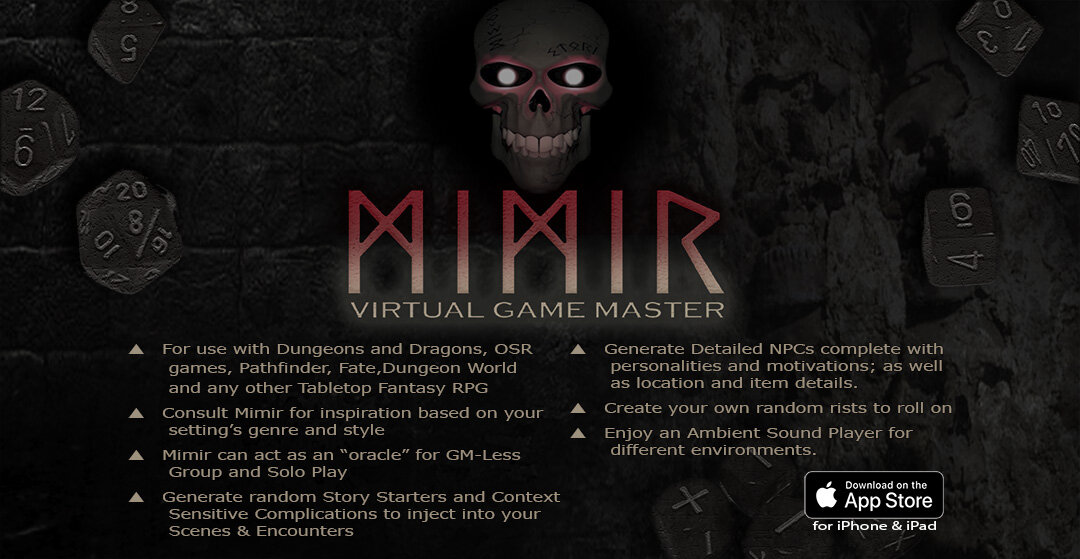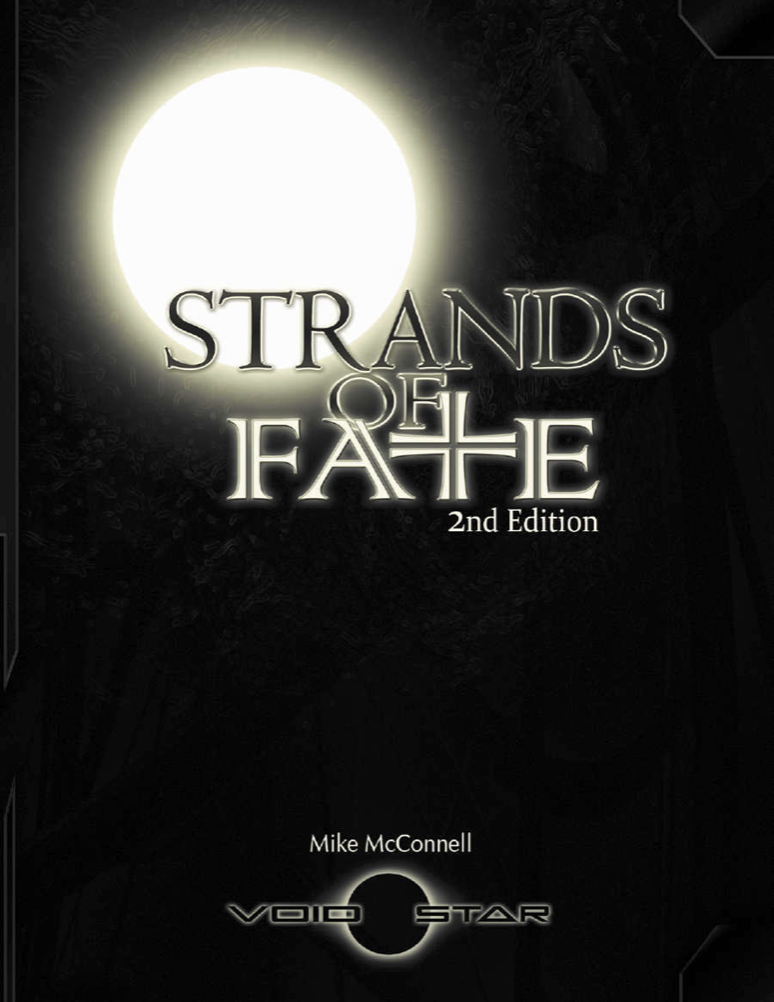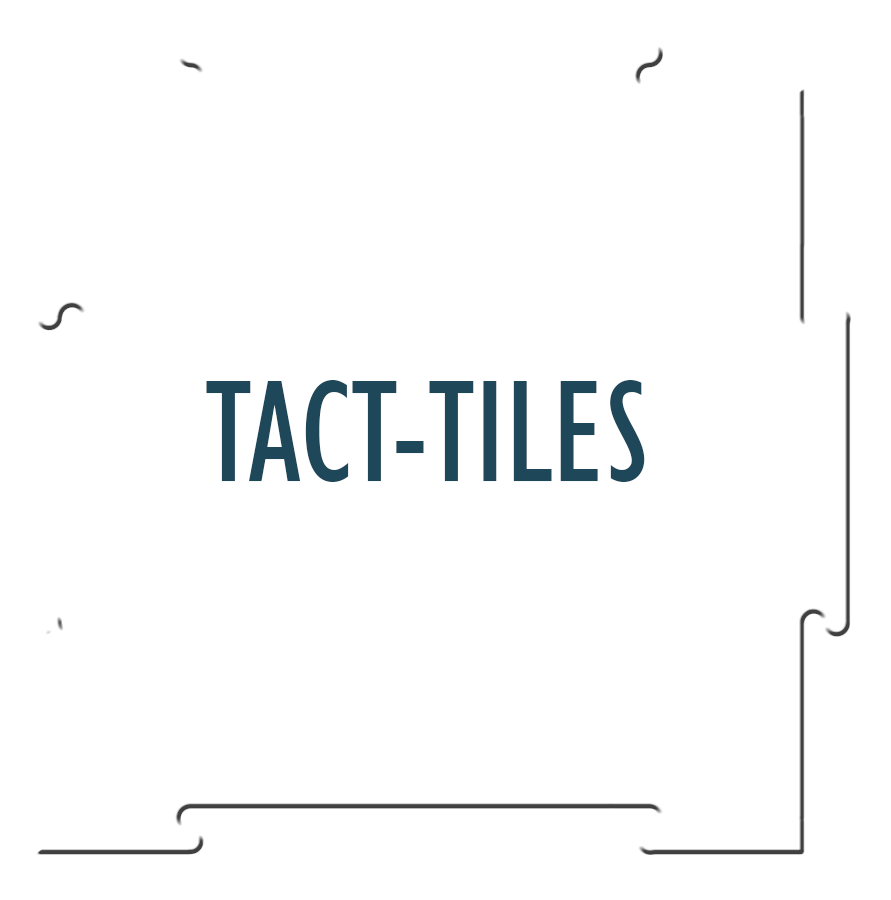It's been a while! A year ago I posted about the need to take something of a sabbatical. And I did, sort of. But as it turns out, I'm not really good at sabbaticals. So, in the time I should have been spending making myself a better person, I've instead been working with a small team of freelancers and playtesters to lay the foundation for the second edition of Strands of Fate.
So let's talk a little bit about that. What is Strands of Fate 2e?
The original Strands of Fate was a labor of love and one of my proudest achievements. And yet, it was way too ambitious of a project for someone who had, at the time, never really published anything before. It was designed to be a massive toolbox, created to empower you to use the Fate game system to play pretty much any sort of adventure game. And while I think it largely succeeded, it did it by sheer brute force and page count.
A Solid Core
With Strands of Fate 2e, we're taking a different, more focused and clear, path to the same destination. Strands 2 is designed around a central core set of rules. These rules, Skills, Aspects, Fate Points, Stress.... the Fate classics; they're all there in the core. They make up a solid foundation upon which all Strands of Fate campaigns are built upon, and remain pretty consistent regardless of genre, power level, and other options.
Is it a Fate Core game? No, not really. Fate was first introduced in Spirit of the Century. The first Strands of Fate was born out of a desire to take what was in SotC and create a generic core rule set. And since that time, Evil Hat has gone on to create their own version of that.
This left Strands of Fate to become something of a diverging branch of Fate. And Strands 2 continues along that line. It's core rules borrow heavily from the work we did with the Fate version of Nova Praxis; which served as our starting point early in development.
Strands of Fate 2e certainly shares a lot of DNA with Evil Hat's Fate Core, but we are not branding it as a Fate Core game. Strands of Fate is its own distinct version of Fate.
Strands and Schemas
So what's beyond the core?
Branching out from the core rules are Strands, distinct rules modules added to, or layered over, the core rules to create a more refined experience. It includes Strands that make Aspects play a larger role in the game, and Strands that make Aspects play a smaller role. There are Strands that up the PC lethality of the game, and Strands that make it safer. There are multiple character advancement options, different initiative options, sanity rules, miniatures rules, and much more.
And unlike Strands 1e, where the variant rules were sprinkled all throughout the book, the Strands in Strands of Fate 2e are clearly noted and confined to their own section of the book. This makes it easier to read and understand the core of the game system before muddying the waters with a tidal wave of options.
And to further help GM's and players tailer their experience, we're introducing Schemas. A Schema is a sort of blueprint for your campaign, and there is a chapter in the book devoted to walking the GM through building his campaign's Schema. It asks lot's of questions; questions like: "How lethal to the PCs do you want the campaign to be?" "How much narrative control do you want players to have?" "How big of a role to you want wealth and equipment to play in your games?" And depending on your answer to these questions, it suggests which Strands you should consider adding to your Schema.
And of course, we provide some sample Schemas. In fact...
"Strands of Cthulhu"
One of the Schema's already in the Alpha version of the book is entitled "Strands of Cthulhu". And as you've probably already figured out, its a Schema that provides advice for using Strands of Fate 2e to run a campaign in which your PCs investigate and confront alien horrors from beyond.
This particular Schema currently clocks in at four pages, in which we provide an overview of Lovecraft's setting, advice for the sorts of characters the PCs should create, some sample Campaign Aspects (which can either be simple flavor, or provide mechanical effects, depending on the Strands you choose), a discussion of the setting's Tech-Level, the character's starting Power and Experience Levels, what Races, Skills, Perks, and Powers are available, and what Strands are required, recommended or expressly not recommended.
It then goes on to introduce the special Mythos Lore Affinity Skill, Mythos Tomes, and some advice about ancient rites and how the GM can use them in the game, as well as how PCs might access and use Mythos Sorcery.
Other sample Schemas will get the same treatment, and cover classic fantasy, modern super heroes, and a few other common genres.
Powers!
One of the things players seems to love about Strands of Fate is the vast array of powers available. And on that front, Strands of Fate 2e once again delivers.
But one of the biggest differences is how Powers are obtained and activated. In the original Strands, each Power had a built-in assumption about how it was activated and/or what the costs where (though most had modifiers that allowed you to change this.)
In Strands 2, the Powers are much more agnostic in that regard. In fact, their write-ups don't even mention how they are activated. How a player gets their Powers, and how they activate them, are explained by special Perks called Aptitudes.
For example, let's look at Arcane Apprentice. When you take the Arcane Apprentice Aptitude, you gain one rank in the Arcana Affinity Skill, gain the Cantrips Meta-Powers, and you may choose one Power with the Ritual Activation Limitation. You may then learn additional Powers as you gain Experience and take additional Perks along the path to becoming an Archmage.
Development Status and Playtesting
Right now we're in the final stages of the Alpha testing. Soon we'll be opening the game up to a semi-public Beta test, in which you'll get a chance to check it out before the Kickstarter launches in March.
Look for more on that near the end of the year!















![Nova Praxis: Savage Worlds Edition [SW]](https://images.squarespace-cdn.com/content/v1/513f57ebe4b0970eaf232dec/1411429136405-VRGAKJO9SF6QPT34HM4E/image-asset.jpeg)

![Machinations: The Nova Praxis GM's Companion [FATE]](https://images.squarespace-cdn.com/content/v1/513f57ebe4b0970eaf232dec/1411429079131-BC5SAOV0KM9HTN3OZBH7/image-asset.jpeg)
![Nova Praxis [FATE]](https://images.squarespace-cdn.com/content/v1/513f57ebe4b0970eaf232dec/1367939683929-QNNP413OLYGL8M41WLW6/NP+Cover+-+Portrait.jpg)
![Nova Praxis Augmented PDF [FATE]](https://images.squarespace-cdn.com/content/v1/513f57ebe4b0970eaf232dec/1363875286527-YO2FZTE5UEEWDRCGJDEL/NP+Cover+-+Portrait.jpg)
![Nova Praxis GM Screen PDF [FATE]](https://images.squarespace-cdn.com/content/v1/513f57ebe4b0970eaf232dec/1364779338460-GU1F5C8859WT56TJP77X/GM+Screen+Cover.jpg)
![Strands of Fate [A FATE Core Rulebook]](https://images.squarespace-cdn.com/content/v1/513f57ebe4b0970eaf232dec/1363875325431-39PZH4IV53HBRVIUSZ22/Strands+of+Fate+Cover.jpg)
![Strands of Power {SoF Supplement]](https://images.squarespace-cdn.com/content/v1/513f57ebe4b0970eaf232dec/1363875360147-J8EQQ90ZOIEOBLSTIEPY/Strands+of+Power+3+1.jpg)
